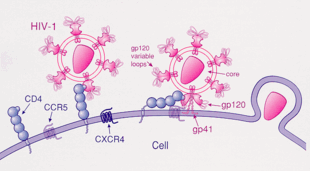CCR5

CCR5(C-C chemokine receptor type 5),中文名:趋化因子受体5[7]或趋化因子C-C亚族受体5[8],也称为CD195。是白细胞表面的一种蛋白质,因此也称为CCR5蛋白质,R5型HIV进入并感染宿主细胞的过程需要借助CCR5蛋白质,控制CCR5蛋白质的基因称为CCR5基因,该基因在人体内的基因座是3p21.31(意为位于3号染色体短臂的2区-1带-子带31上)。[9][10][11][12][13][14][15]
某些人群的基因组中含有此基因的一个突变型,称为CCR5-Δ32,与普通CCR5基因相比,有一段长为 32 碱基对的缺失,其表达产物无法被HIV识别和结合,因此可对R5型HIV引起的艾滋病免疫,[10][11][12][13][14][15]但对于仅使用CXCR4受体蛋白的X4型HIV却没有免疫能力[16][17]。CCR5的另外一种突变CCR5-893(−)亦同样对部分艾滋病具有免疫作用[18]。
功能
[编辑]CCR5是一种G蛋白偶联受体,属于整合型膜蛋白的β趋化因子受体家族成员[7][19][20],在CC趋化因子组中起趋化因子受体的作用[19]。
CCR5主要在T细胞,巨噬细胞,树突细胞,嗜酸性粒细胞,小胶质细胞和乳腺癌或前列腺癌的细胞亚群中表达。[21][22]CCR5在癌症变性过程中被选择性诱导表达,且不在正常乳腺或前列腺上皮细胞中表达。大约50%的人类乳腺癌表达了CCR5,主要是三阴性乳腺癌。[21]CCR5抑制剂阻断了表达CCR5的乳腺癌细胞和前列腺癌细胞的转移,表明CCR5或可作为一种新的治疗靶点。[21][22][23]最近的研究表明,CCR5在癌细胞亚群中表达,具有癌症干细胞的特征,后者已知可激发对治疗的抗性,而CCR5抑制剂可以增强现有化疗技术的细胞杀伤作用[24]。
CCR5在正常免疫中的作用尚不清楚[25],《复杂疾病遗传学》(Genetics of Complex Disease)这一本书籍指出:“一般而言,CCR5并不会影响免疫反应,但它在对西尼罗河病毒感染的免疫反应中扮演重要的角色”[26]。CCR5-Δ32基因虽对部分艾滋病具有免疫作用,但一篇2015年的综述指其与多发性硬化相关[27],不过在整体研究中它跟自体免疫性疾病的关系存有矛盾[28]。其跟肿瘤的关系则欠详细记录[29]。此外CCR5-Δ32可能会使携带者在感染西尼罗河病毒后出现更严重的神经系统疾病[26]。
参考资料
[编辑]- ^ 與CCR5相關的疾病;在維基數據上查看/編輯參考.
- ^ 對CCR5起作用的藥物;在維基數據上查看/編輯參考.
- ^ 3.0 3.1 3.2 GRCh38: Ensembl release 89: ENSG00000160791 - Ensembl, May 2017
- ^ 4.0 4.1 4.2 GRCm38: Ensembl release 89: ENSMUSG00000079227 - Ensembl, May 2017
- ^ Human PubMed Reference:. National Center for Biotechnology Information, U.S. National Library of Medicine.
- ^ Mouse PubMed Reference:. National Center for Biotechnology Information, U.S. National Library of Medicine.
- ^ 7.0 7.1 邱磊. 超氧化物歧化酶介导趋化因子受体 5 的功能. 第二军医大学. [2018-12-02]. (原始内容存档于2019-06-03).
- ^ 朱平,王彦宏,樊春梅,张浩,黄向阳,吴振彪,/冷南. 趋化因子受体 CCR5 及其配体在类风湿关节炎患者滑液及滑膜中的表达. 中华医学杂志. 2001, (17) [2018-12-02]. (原始内容存档于2018-12-03).
- ^ GRCh38: Ensembl release 89: ENSG00000160791 Summary - Homo sapiens. Ensembl. [2018-11-27]. (原始内容存档于2022-03-21) (英国英语).
- ^ 10.0 10.1 de Silva E, Stumpf MP. HIV and the CCR5-Delta32 resistance allele. FEMS Microbiology Letters. Dec 2004, 241 (1): 1–12. PMID 15556703. doi:10.1016/j.femsle.2004.09.040.
- ^ 11.0 11.1 Hütter G, Nowak D, Mossner M, Ganepola S, Müssig A, Allers K, Schneider T, Hofmann J, Kücherer C, Blau O, Blau IW, Hofmann WK, Thiel E. Long-term control of HIV by CCR5 Delta32/Delta32 stem-cell transplantation. The New England Journal of Medicine. Feb 2009, 360 (7): 692–8. PMID 19213682. doi:10.1056/NEJMoa0802905.
- ^ 12.0 12.1 Allers K, Hütter G, Hofmann J, Loddenkemper C, Rieger K, Thiel E, Schneider T. Evidence for the cure of HIV infection by CCR5Δ32/Δ32 stem cell transplantation. Blood. Mar 2011, 117 (10): 2791–9. PMID 21148083. doi:10.1182/blood-2010-09-309591.
- ^ 13.0 13.1 Zhen A, Kitchen S. Stem-cell-based gene therapy for HIV infection. Viruses. Jan 2014, 6 (1): 1–12. PMC 3917429
 . PMID 24368413. doi:10.3390/v6010001.
. PMID 24368413. doi:10.3390/v6010001.
- ^ 14.0 14.1 Kay MA, Walker BD. Engineering cellular resistance to HIV. The New England Journal of Medicine. Mar 2014, 370 (10): 968–9. PMID 24597871. doi:10.1056/NEJMe1400593.
- ^ 15.0 15.1 Tebas P, Stein D, Tang WW, Frank I, Wang SQ, Lee G, et al. Gene editing of CCR5 in autologous CD4 T cells of persons infected with HIV. The New England Journal of Medicine. Mar 2014, 370 (10): 901–10. PMC 4084652
 . PMID 24597865. doi:10.1056/NEJMoa1300662.
. PMID 24597865. doi:10.1056/NEJMoa1300662.
- ^ Coakley, E., Petropoulos, C. J. and Whitcomb, J. M. Assessing chemokine co-receptor usage in HIV. Curr. Opin. Infect. Dis. 2005, 18 (1): 9–15. PMID 15647694. doi:10.1097/00001432-200502000-00003.
- ^ Berger, EA; Doms, RW; Fenyö, EM; Korber, BT; Littman, DR; Moore, JP; Sattentau, QJ; Schuitemaker, H; et al. A new classification for HIV-1. Nature. 1998, 391 (6664): 240. PMID 9440686. doi:10.1038/34571.
- ^ Schweneker, Marc; Bachmann, André S; Moelling, Karin. JM4 is a four-transmembrane protein binding to the CCR5 receptor. FEBS Letters. 2005-03-14, 579 (7): 1751–58 [2018-12-02]. PMID 15757671. doi:10.1016/j.febslet.2005.02.037. (原始内容存档于2019-02-15) (英语).
- ^ 19.0 19.1 CCR5 - chemokine (C-C motif) receptor 5 (gene/pseudogene). Genetics Home Reference. (原始内容存档于2009-09-24).
- ^ Samson M, Labbe O, Mollereau C, Vassart G, Parmentier M. Molecular cloning and functional expression of a new human CC-chemokine receptor gene. Biochemistry. Mar 1996, 35 (11): 3362–7. PMID 8639485. doi:10.1021/bi952950g.
- ^ 21.0 21.1 21.2 Velasco-Velázquez M, Jiao X, De La Fuente M, Pestell TG, Ertel A, Lisanti MP, Pestell RG. CCR5 antagonist blocks metastasis of basal breast cancer cells. Cancer Research. Aug 2012, 72 (15): 3839–50. PMID 22637726. doi:10.1158/0008-5472.CAN-11-3917.
- ^ 22.0 22.1 Sicoli D, Jiao X, Ju X, Velasco-Velazquez M, Ertel A, Addya S, Li Z, Andò S, Fatatis A, Paudyal B, Cristofanilli M, Thakur ML, Lisanti MP, Pestell RG. CCR5 receptor antagonists block metastasis to bone of v-Src oncogene-transformed metastatic prostate cancer cell lines. Cancer Research. Dec 2014, 74 (23): 7103–14. PMC 4294544
 . PMID 25452256. doi:10.1158/0008-5472.CAN-14-0612.
. PMID 25452256. doi:10.1158/0008-5472.CAN-14-0612.
- ^ Velasco-Velázquez M, Xolalpa W, Pestell RG. CCL5/CCR5 in breast cancer. Expert Opin Ther Targets. Nov 2014, 18 (11): 1265–75. PMID 25256399. doi:10.1517/14728222.2014.949238.
- ^ Jiao X, Velasco-Velázquez MA, Wang M, Li Z, Rui H, Peck AR, Korkola JE, Chen X, Xu S, DuHadaway JB, Guerrero-Rodriguez S, Addya S, Sicoli D, Mu Z, Zhang G, Stucky A, Zhang X, Cristofanilli M, Fatatis A, Gray JW, Zhong JF, Prendergast GC, Pestell RG. CCR5 Governs DNA Damage Repair and Breast Cancer Stem Cell Expansion. Cancer Res. Apr 2018, 78 (7): 1657–71. PMID 29358169. doi:10.1158/0008-5472.CAN-17-0915.
- ^ Barmania F, Pepper MS. C-C chemokine receptor type five (CCR5): An emerging target for the control of HIV infection. Applied & Translational Genomics. 2013, 2 (a): 3–16. doi:10.1016/j.atg.2013.05.004.
- ^ 26.0 26.1 Donaldson, Peter; Daly, Ann; Ermini, Luca; Debra, Bevitt. Genetics of Complex Disease. Garland Science. 2015: 241 [2018-12-02]. ISBN 9780815344919. (原始内容存档于2018-11-29).
- ^ Ghorba, Khodayar; Hassanshahi, Gholamhossein; Momeni, Mohammad; Zare-Bidaki, Mohammad; Arababadi, Mohammad Kazemi; Kennedy, Derek. Is the CCR5 Δ 32 Mutation Associated with Immune System-Related Diseases?. Inflammation. 2013-06, 36 (3): 633–42 [2018-11-27]. PMID 23250822. doi:10.1007/s10753-012-9585-8. (原始内容存档于2018-06-17) (英语).
- ^ Ascierto, PA; Stroncek, DF; Wang, E. Developments in T Cell Based Cancer Immunotherapies. Humana Press. 2015: 117 [2018-12-02]. ISBN 978-3-319-21167-1. (原始内容存档于2018-11-29).
- ^ Rezaei, Nima. Cancer Immunology: A Translational Medicine Context. Springer. 2015: 135 [2020-09-25]. ISBN 978-3-662-44006-3. (原始内容存档于2019-02-15).





